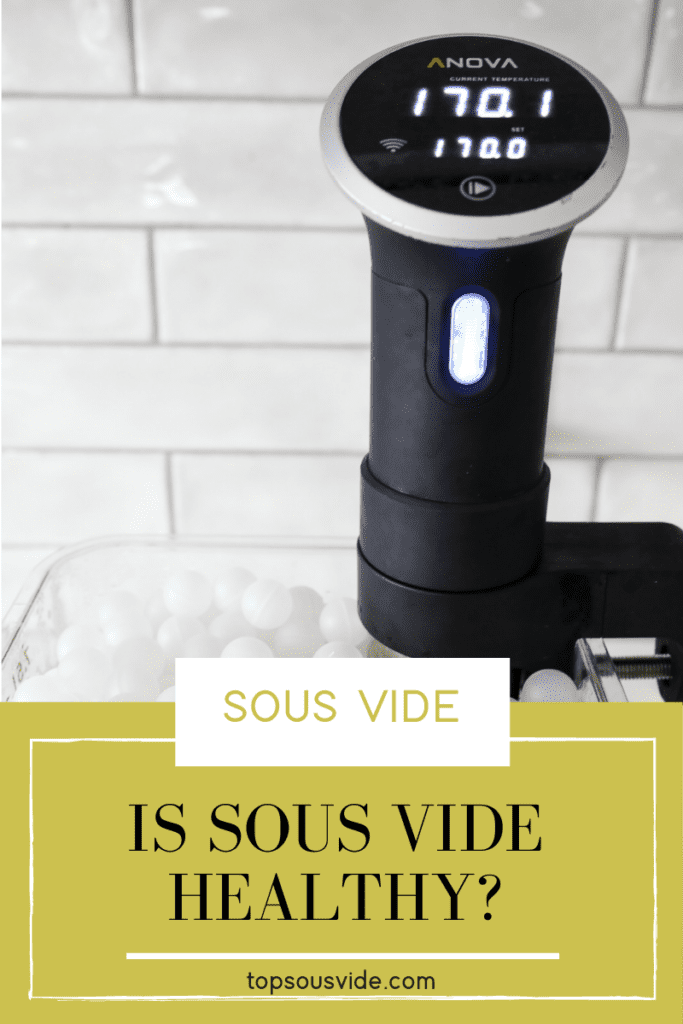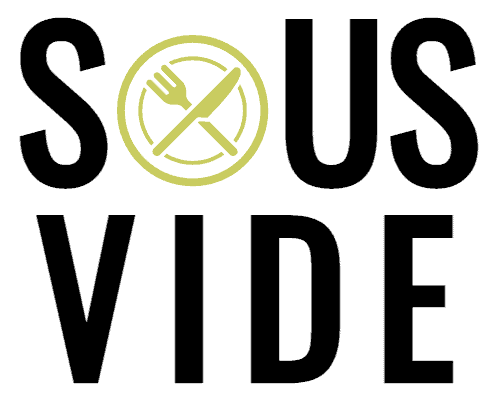Sous vide is famed as a cooking process that delivers full-flavored, beautifully tender meals time after time. But there is another sous vide topic that is less widely discussed.
Is Sous Vide healthier? Yes, sous vide cooking is healthier.
There are a number of health benefits from cooking food sous vide. Less oil and fats, as well as better retention of vitamins and nutrients are just a couple.
These days we are all far more educated about the importance of a healthy diet. This means that often we avoid eating too much red meat, or fat, or dairy. In other words, all the food we love.
Sous vide can greatly improve the healthiness of foods that we would otherwise consider bad for us, by changing the way we cook.
There are several reasons why sous vide food is a healthy option. I discuss the range of health benefits in more detail below.
- Related Article: What is Sous Vide Cooking?
Table of Contents
What are the Health Benefits of Sous Vide?

1. Uses Less Oils and Fats
When you cook sous vide, you need less oils and fats compared to traditional methods.
Cutting out the amount of fat and oil we consume in our diet is one of the biggest steps we can take to improve our health and diet. Heart disease, cholesterol levels, and weight gain are all associated with high-fat diets.
Sous vide requires far less use of fats and oils than on the stovetop or oven would. Often, fats and oils are simply added as a lubricant to stop ingredients from sticking to the surface like pans, but this isn’t required in sous vide.
Even if you need to sear a piece of meat, the amount of oil required is greatly reduced. You can even sous vide veggie burgers.
Although the dishes you cook use less fat, the flavor isn’t affected. The sous vide process lets the natural oils already present in the food permeate throughout the entire dish.
2. Better Retention of Vitamins and Minerals
Conventional methods like boiling, baking, or frying result in a loss of essential nutrients in the food. One study has shown that all Vitamin C in certain vegetables was lost when the vegetables were boiled.
Vitamin C is not alone in this either. Many other minerals and vitamins are either water-soluble, oil-soluble, or both. This includes all the B Vitamins and minerals like potassium.
It isn’t just the cooking medium either, nutrient loss can be attributed to excess heat and exposure to oxygen. You keep the nutritional advantages of quality ingredients, since there’s no loss.
With the sous vide cooking technique, the food is contained in a vacuum-sealed bag that traps all the nutrients in. There is no evaporation, no high temperatures, and no exposure to oxygen.
3. Makes it Simple to Batch Cook Meals
Many of us lead busy lifestyles that don’t leave much time for preparing meals daily. A result of this is that we eat far too many processed and fast foods. There’s not enough time to make quality, healthy food choices.
Sous vide makes it easy to prepare a batch of meals in advance. But it’s better than just being able to cook in advance.
Left in the bag, sous vide meals can last for days in the fridge and even longer in the freezer. When you want to eat, simply pop the plastic bags into your sous vide machine and warm the food contents to a precise temperature.
There isn’t a simpler way to cut down on the amount of junk food we eat.
Eating more home cooking is a great way to improve the overall healthiness of your diet. Studies, including one by Johns Hopkins University, have all concluded that eating more home-prepared meals is one of the major steps towards a healthier diet.
The same report also noted that people who eat more home-cooked meals, consume fewer calories.
4. Reduced Salt in Meals
Sous vide cooking is renowned for the flavor of the food it produces. Flavor is not lost like traditional boiling methods during sous vide cooking. The natural flavors of the food are greatly enhanced and kept due to the longer cook time.
This process of locking the flavors in the airtight vacuum bags means that it isn’t necessary to add as much salt or other flavor enhancers. You can still add spices and a little olive oil if you want, but I use less than through traditional methods of cooking.
We already eat far too much salt in our diets, nine out of ten Americans eat too much salt. Too much salt can lead to high blood pressure and this increases the risks of heart attacks and strokes.
5. It Can Improve Food Safety
It may sound counter-intuitive to say that using a lower temperatures can improve food safety by reducing the chance of contamination. If you stick to a few guidelines, then this method is an extremely safe way to cook.
Ultimately, the point of sous vide cooking is to cook the food at a precise temperature in a sous vide water bath. Done correctly, a temperature-controlled water bath ensures that the food is evenly cooked throughout.
When cooking at higher temps it is all too easy to overcook the outer edges and leave the inside undercooked.
If you follow the recommendations for minimum cooked temperatures, then you can be sure of staying within the safe food range and outside the “danger zone” of bacteria buildup.
I have listed the recommendations for some of the most popular foods below. A full list of food can be found on the U.S. Food Safety website, including seafood and eggs.
| Food | Minimum Internal Temperature |
| Steak, Chops, Roasts | 145° F (63° C) |
| Poultry | 165° F (74° C) |
| Fresh Pork and Ham | 165° F (74° C) |
Sous vide recipes will often say to cook below those temperatures, but with the slow process, pasteurization will prevent food poisoning through salmonella.
The longer periods of time at the lower temperatures results in pasteurized food and salmonella is reduced to the federal government-approved levels.
This Polyscience chart shows the government-specified temperatures and times that will result in pasteurization:
| Center temperature | Hold time |
| 130ºF | 112 minutes |
| 140ºF | 11 minutes |
| 150ºF | 1 minute |
| 155ºF | 5 seconds |
| 158ºF | instant (less than 1 second) |
For instance, if you’re weary of consuming raw eggs in any number of good things they’re called for, use our sous vide pasteurized eggs recipe. Then you can worry-free enjoy raw eggs in things like hollandaise, aoili, cake icing, or in your favorite bevvy for some texture.
6. Aids Digestion
Despite cooking now being something of an art form, our distant ancestors cooked purely as a way of easing the digestive process.
Because it cooks the food gently, but thoroughly, it guarantees that the nutrients, proteins, and carbohydrates in the food are made as “bioavailable” as possible. In other words, cooking makes it easier for us to digest food and sous vide cooking does this more efficiently than traditional methods.
During the process, the collagen that is present in animal proteins breaks down into gelatin. Gelatin is easier for our digestive systems to absorb.
But here’s the magic part – Collagen is crucial for our health and quality of life for several reasons. Collagen is what our hair and nails are made of, it aids in skin health, it strengthens tendons and ligaments, and it is beneficial to gut health.
The magic is that the vital amino acids that make up collagen proteins are still present in the gelatin. They’re just present in a form that our bodies can access more easily.
7. It Doesn’t Char Food
Unless you are particularly heavy when searing your food, another health benefit of sous vide cooking is less charring of food.
There are proven links that show the hydrocarbons, including Heterocyclic amines (HCAs) and polycyclic aromatic hydrocarbons (PAHs), that are formed when cooking meats at high temperatures are carcinogenic.
Carcinogenics have been shown to lead to cancer and a big talking point when comparing sous vide vs grilling.
Sous vide cooks meats at a temperature low enough that these hydrocarbons don’t form. Even when cooking steak, giving it a quick sear at the end will produce some, but not as many as high-heat methods could.
Use a good kitchen torch to sear will give us the perfect steak. If you’re looking for a searing guide, check out the How to Sear Sous Vide Guide.
Is Sous Vide Healthier? Final Thoughts
Sous vide cooking is a great way to cook your food, and it has all sorts of perks that will be sure to delight both you and your family.
From less oil, fats, vitamins and nutrients retained in the process, it is healthier than traditional boiling or frying methods.
If this sounds like something up your alley (or kitchen), then buy yourself a sous vide cooker and get going!
FAQs
Yes, sous vide is safe and healthy. If done correctly, with the right ingredients cooked at the correct temperature, it produces healthy meals that are safe and nutritious.
Sous vide produces healthy, safe, and nutritious meals. However, as with all methods, there are potential dangers if guidelines aren’t followed that can lead to problems. To keep it as safe as possible always make sure that time and temperature guidelines are adhered to.
Another potential danger is the type of sous vide bag used for the cooking process. Make sure that this is listed as being BPA-free. Stay away from BPA plastics that can leak harmful chemicals into the food.
No, the sous vide method isn’t dangerous. As long as the machines are used correctly, following the right temperature and time recommendations will ensure the food is cooked all the way through. Then it presents no danger to the consumer.
It is a surprisingly versatile cooking method, it can deal with everything from eggs to briskets. However, there are some things to avoid.
One example is mechanically tenderized meat, the process of tenderizing the meat can push surface bacteria into the body of the meat.
Bay leaves should also be avoided, although they pose no health risks, they do tend to give dishes a metallic taste.
One of the great things of sous vide cooking is that the method makes it incredibly difficult to overcook dishes. But there are limitations on more delicate meats changing textures (too tough or even mushy) if cooked too long.
If the recipe calls for 1-2 hours, try not to go 4 or more hours. While tougher cuts of meat like ribs can happily sit in a sous vide bath for 24hrs upwards. Follow the recipes and what they suggest.
If you are worried about BPA, the answer is simply to avoid bags that are manufactured using BPA. Luckily, most manufacturers of use BPA-free plastics.
Check out the best sous vide bags article for more information.
Yes, sous vide cooking can kill all harmful bacteria. However, it is important to stick to the time and temperature guidelines for what you are making.
If you are cooking close to the temperature threshold that allows for bacteria to grow and prevent pasteurization, be sure to cook long enough that the food is safe.
Be sure to check out the Best Sous Vide Starter Kit to get you started!
